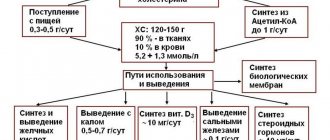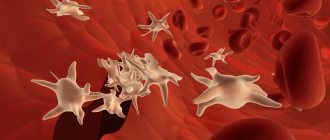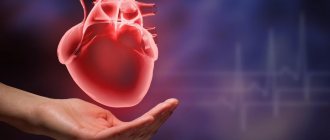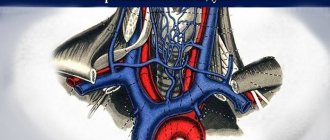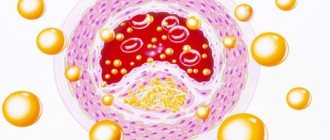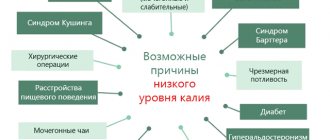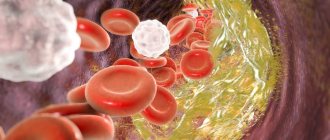When irritating the peripheral end of the cut vagus nerve, the following changes were revealed:
1. Negative chronotropic
effect (slowing down the rhythm of contractions).
2. Negative inotropic
the effect is a decrease in the amplitude of contractions.
3. Negative bathmotropic
the effect is a decrease in myocardial excitability.
4. Negative dromotropic
the effect is a decrease in the speed of excitation in cardiomyocytes.
Irritation of the vagus nerve can cause a complete stop of cardiac activity, resulting in complete blockade of excitation in the AV node. However, as stimulation continues, the heart resumes contractions, and escape
heart from the influence of the vagus nerve.
Effects of the sympathetic nerve
. The first neurons of the sympathetic nerves are located in the lateral horns of the 5 upper segments of the thoracic spinal cord. Second neurons from the cervical and upper thoracic sympathetic ganglia go mainly to the ventricular myocardium and conduction system. Their effect on the heart was studied by I.F. Zion. (1867), I.P. Pavlov, W. Gaskell. Their opposite effect on the activity of the heart was established:
1. Positive chronotropic
effect (increased heart rate).
2. Positive inotropic
effect (increased contraction amplitude).
3. Positive bathmotropic
effect (increased myocardial excitability).
4. Positive dromotropic
effect (increasing the speed of excitation).
Cardiac nerve mediators and their effects
When the sympathetic and vagus nerves are simultaneously stimulated, the action of the vagus predominates. Despite the opposing influences of the sympathetic and vagus nerves, they are functional synergists. Depending on the degree of filling of the heart and coronary vessels with blood, the vagus nerve can also have the opposite effect, i.e. not only slow down, but also enhance the activity of the heart.
The transfer of excitation from the endings of the sympathetic nerve to the heart is carried out using the mediator norepinephrine
.
It breaks down more slowly and lasts longer. Acetylcholine
is produced at the endings of the vagus nerve . It is quickly destroyed by ACh esterase, so it has only a local effect. When both nerves (sympathetic and vagus) are transected, a higher rhythm of the AV node is observed. Consequently, its own rhythm is much higher than that under the influence of the nervous system.
The nerve centers of the medulla oblongata, from which the vagus nerves extend to the heart, are in a state of constant central tone. From them constant inhibitory influences come to the heart. When both vagus nerves are cut, heart contractions increase. The following factors influence the tone of the vagus nerve nuclei: increased levels of adrenaline, Ca 2+ ions, and CO2 in the blood. Breathing influences: when inhaling, the tone of the vagus nerve nucleus decreases, when exhaling, the tone increases and heart activity slows down (respiratory arrhythmia).
Regulation of cardiac activity is carried out by the hypothalamus, limbic system, and cerebral cortex.
Receptors of the vascular system, forming vascular reflexogenic zones, play an important role in the regulation of the heart.
The most significant: aortic, sinocarotid zone, pulmonary artery zone, the heart itself. The mechano- and chemoreceptors included in these zones are involved in stimulating or slowing down the activity of the heart, which leads to an increase or decrease in blood pressure.
“All diseases come from nerves” is a well-known saying. And it is not unfounded, since nerve endings connect to all organs without exception. The heart is especially sensitive to various types of nervous disorders. Under severe stress and emotional stress, its activity may be disrupted, and it’s good if everything forms on its own. But in some cases, neurological arrhythmias occur, which bring significant discomfort to a person.
Quite healthy people may experience several arrhythmias per day. But at the same time, they do not cause any changes in the general condition of a person.
Some people have a mentality that is especially susceptible to various nervous disorders. Minor stress or worries make them clutch at their hearts. Some might think this is fake. In fact, a person begins to have an attack of arrhythmia and in such cases appropriate assistance should be provided. Moreover, such a condition can be observed not only in old age, but also in young people.
Video Arrhythmia: If I’m young, then I can’t have arrhythmia?
Back and heart pain, increased sweating
The heart is the engine of a person, and it needs proper care to function smoothly for many years.
When your back hurts, you sweat, your heart beats faster than usual for no obvious reason, you should consult a doctor. This way you can diagnose an unpleasant disease in time and begin treatment.
Each of these symptoms can be caused by ordinary fatigue or more serious problems.
Cardiovascular diseases are serious illnesses; treatment should not be delayed
Causes of elevated heart rate
Cardiovascular diseases cause a lot of inconvenience and can quickly lead to death. To avoid unpleasant consequences, pay attention to any unusual changes in your heart rate.
Cold sweaty hands, sharp pain in the heart radiating to the shoulder blades, sweating and a noticeably rapid heartbeat will indicate to you diseases such as VSD, tachycardia or ischemic heart disease.
It is important to determine the cause of the illness in time to avoid complications.
Normally, in a healthy person, the heart beats 80 to 100 times per minute.
A rapid heartbeat at rest already makes you think about pathology or a hidden disease.
The main symptoms of tachycardia are: fatigue, shortness of breath with minimal exertion, severe dizziness, lack of air, attacks of weakness.
Physiological tachycardia can occur after exercise, as a result of stress or severe fear. In this case, the attack passes quickly and does not cause any inconvenience.
This type of tachycardia is called physiological; almost anyone can be susceptible to such attacks.
Another type of tachycardia is pathological and appears as a consequence of another disease, nervous disorders or alcohol poisoning. In this case, it is important to determine the source of the symptoms and treat it.
The doctor will be able to give you an accurate diagnosis only after an ECG to determine the beginning and end of the attack and its nature. After the necessary procedures and tests, a treatment that is suitable for your case will be prescribed.
Cardiac ischemia
The task of the heart is to saturate the entire body with oxygen through the blood. Uninterrupted circulation of oxygen is also important for the heart itself; it is supplied to the human motor by two coronary arteries. And when they do not supply enough saturated blood, the heart stops functioning normally. This condition is called coronary heart disease.
Eating salty, fatty foods and alcohol leads to blockage of blood vessels
The main cause of vascular obstruction and a possible cause of a future heart attack is blockages or atherosclerosis. Vasospasms, high blood viscosity and blood clots also play a role.
With this disease, the blood vessels become clogged with deposits of fatty acids that form plaques. They stick to the walls of blood vessels and, narrowing them, prevent normal blood flow. When the coronary arteries become blocked, the heart stops receiving enough oxygen and becomes significantly weaker.
Heart disease can develop unnoticed over several years without causing concern to a person. Obvious symptoms and weakness of the body appear when the blockage blocks about 70% of the lumen in the artery. Higher rates threaten heart attack and death.
Main causes of IHD
The development of the disease is facilitated by many factors that accompany modern humans every day. Among the main reasons, the following should be highlighted:
- Overweight, obesity.
- Excessive alcohol consumption and smoking.
- Low physical activity, sedentary lifestyle.
- Junk food, lack of vegetables and greens in the diet.
- Hereditary predisposition.
- Accompanying illnesses.
Taking care of your health should not end with preventive examinations and taking vitamins. Proper and timely nutrition, giving up bad habits, and daily exercise will significantly strengthen not only your muscles, but also the walls of your blood vessels, which will protect you from stroke and myocardial infarction.
Diagnosing IHD at home is almost impossible, especially in the early stages. Therefore, middle-aged men should periodically check with a doctor to avoid such a dangerous and insidious disease.
Vegetovascular dystonia. Causes and symptoms
This syndrome includes disorders of autonomic functions of different origins and manifestations, caused by a disorder of their nervous regulation. This condition occurs in the form of neurosis, which imitates the symptoms of other diseases.
Excess weight contributes to the accelerated development of cardiovascular diseases
Severely increased heart rate, sharp and severe pain in the chest or back, cold extremities, sweating, fatigue, rapid breathing, sudden weakness. Shooting pain in the heart area and chills may also be among these symptoms.
The situation is worsened by concomitant depression, emotional instability, anxiety, hypochondria, and smoking.
To even out the situation, doctors advise doing yoga and breathing exercises, following a daily routine, and giving the body proper rest.
It is important to sleep at least 8 hours at night, without overloading your brain with too loud, harsh music, movies and news before bed. It is worth ensuring a constant flow of fresh air into the room.
Any cardiovascular disease is a risk of ending up in the hospital or even dying.
Today, anyone can get a heart attack as a consequence of advanced ischemic heart disease. It is important to maintain the general tone of the body so as not to miss alarm bells. Routine check-ups with doctors and conscientious health care will help avoid a lot of problems that young people are increasingly facing.
Remember that an absolutely healthy person is a myth, and the condition of your body is only in your hands.
Back and heart pain, increased sweating Link to main publication
Source: https://vpotu.ru/potlivost/bolit-serdcze
Description of neurological arrhythmia
Arrhythmia should be understood as a rhythm disturbance that differs from normal sinus rhythm. In a healthy state, it is expressed in an adult heart rate of 60 to 90 times per minute, as well as a regular and regular heartbeat wave. If the heart is affected by unfavorable factors, then the rhythm and frequency are disturbed and arrhythmia is observed.
According to the nature of their severity, arrhythmias can be either frequent or rare, with an increase or, conversely, a decrease in heart rate. When the conduction system is involved in the pathological process, blockades of cardiac activity may occur.
The key mechanism for the development of arrhythmias is a violation of the basic functions of the heart: impulse conduction, myocardial contraction, excitation and refractoriness of cardiomyocytes. Since the heart is richly innervated, increases and decreases in heart rate are often associated with the activity of certain nerve fibers:
- the vagus nerves inhibit cardiac activity;
- the sympathetic nervous system increases the output and speeds up the rhythm.
The influence of the vagus and sympathetic nerves is interconnected, therefore, when the former are excited, the activity of the latter decreases and vice versa.
Symptoms of neurological arrhythmia
Basically, in patients with neurological arrhythmia, symptoms occur suddenly, several times a day or from time to time. Often the symptoms of the disease are presented in the following sequence:
- palpitations appear;
- there are interruptions in the functioning of the heart;
- feeling weak;
- the heart “jumps out of the chest”;
- “darkens” in the eyes.
Against the background of such sensations, fear for their health and life in general develops, so patients turn to a cardiologist. In fact, such conditions are treated by cardiologists together with neurologists. Only then can a positive result in the treatment of neurological arrhythmia be achieved.
In 50% of patients with neurological arrhythmia, a disturbed perception of reality is noted when a person indicates, for example, a rapid pulse, but such a violation is not detected during testing.
A constant feeling of fear makes a person depressed. The patient may withdraw into himself and become less social. If he did manage to get an appointment with a doctor, he describes his experiences colorfully and in as much detail as possible. In general, arrhythmia brings more psychological discomfort than physical discomfort. In the presence of serious disorders associated with organic pathology, neurological arrhythmias such as fibrillation or flicker occur, which pose a danger to humans.
Development mechanism
Weakness, dizziness and rapid heartbeat have a common development mechanism. Due to certain irritating factors, tachycardia occurs. As the heart rate increases, hemodynamic disruptions occur, which impair the nutrition of the brain and other tissues. The severity of manifestations depends on individual tolerance, the condition of the blood vessels, the degree of maintaining the constancy of cerebral (brain) blood flow and the contractility of the heart.
If there is a sudden interruption in cerebral blood supply, the patient will feel dizzy. If the failure lasts a couple of minutes, loss of consciousness is possible. The feeling of weakness occurs due to frequently recurring attacks of tachycardia, against the background of which oxygen starvation of the tissues manifests itself.
Causes of neurological arrhythmia
A person’s emotional state directly affects the functioning of the heart. Under the influence of emotions, special vasoconstrictor nerves change the lumen of blood vessels. Therefore, any physical conditions (fear, anger, intense work) or pathological disorders of the nervous system (neuritis, neuroses, neuralgia) lead to changes in the activity of the heart.
Neurological arrhythmia occurs in many diseases associated with the nervous system and, first of all, with the brain:
- acute cerebral pathology (stroke);
- traumatic brain injuries;
- infectious diseases of the nervous system (meningitis, encephalitis);
- tumor processes in the brain;
- autonomic polyneuropathy, often developing against the background of alcoholism and diabetes.
Arrhythmia of neurological origin may be the first sign of developing epilepsy. With this disease, foci of excitation are formed in the brain, which activate cardiac activity. Since epilepsy attacks occur periodically, arrhythmia also develops from time to time, but this does not mean that the pathological condition is not dangerous.
Myocardial infarction
One form of coronary artery disease is myocardial infarction, which is characterized by death of the heart muscle. This disease is not uncommon, so many people are interested in what symptoms are observed? One of the main ones is an increased painful sensation behind the sternum lasting up to 20 minutes. The pain is so severe, squeezing and squeezing that patients experience fear of death, the level of adrenaline in the blood increases, and as a result, sweating increases. In addition to increased sweating, there is shortness of breath, low blood pressure, rapid heartbeat, weakness, nausea, and it becomes difficult to breathe.
Types of neurological arrhythmia
The disease is manifested by various heart rhythm disorders. It all depends on the severity of the pathological process.
- If the arrhythmia is associated with organic damage to the brain or the conduction system of the heart, then heart block, ventricular fibrillation and atrial flutter/fibrillation appear. Each of these forms of arrhythmia poses a danger to a person, as the risk of cardiac arrest increases. Self-resolution of these conditions occurs in very rare cases, so it is better to seek medical help promptly.
- Cardiac disorders of functional origin are most often associated with a person’s emotional state. Against the background of anxiety, stress, after physical or psychological fatigue, sinus or paroxysmal tachycardia, sinus bradycardia, and extrasystole most often develop. These conditions in themselves are not considered dangerous, but if they occur regularly and for a long time, you should contact a cardiologist for a thorough diagnosis of the cardiovascular system.
Adrenaline rate
The norm depends on the age of the person.
| Age, years | Norm, mcg/day |
| Newborns | 0…10 |
| 1 – 2 | 0…3,5 |
| 3 – 4 | 0…6 |
| 5 – 10 | 0,2…10 |
| 11 – 17 | 0,6…20 |
| 18 – 90 | 0…20 |
Diagnosis of neurological arrhythmia
Any heart rhythm disturbance must be confirmed by an electrocardiographic study. Each type of arrhythmia has specific ECG signs:
- sinus tachycardia is manifested by a sinus, regular rhythm and heart rate higher than the age norm;
- sinus bradycardia - sinus, regular rhythm and heart rate less than the age norm;
- paroxysmal tachycardia - heart rate more than 150 times per minute, the presence of sudden attacks, on the ECG it looks like extrasystoles that come one after another;
- heart blockades - conduction slowdown, determined at a level corresponding to the localization of the lesion, the severity of the pathology is assessed by the loss of complexes;
- atrial flutter - non-sinus rhythm against the background of an F wave with the same frequency and amplitude, heart rate is up to 350 times per minute;
- atrial fibrillation - non-sinus rhythm is accompanied by the appearance of an f wave and a heart rate of more than 350 times per minute. In contrast to flutter, atrial fibrillation exhibits an irregular ventricular rhythm.
In addition, X-ray, magnetic resonance and ultrasound examinations can be performed to help conduct a comprehensive examination of the patient to identify the root cause of the development of not only neurological arrhythmia, but also the underlying disease that caused dysfunction of the autonomic nervous system.
Treatment and prognosis for neurological arrhythmia
Today, neurocardiologists practice prescribing vegetative-corrective therapy, which often helps to normalize the balance of the autonomic nervous system. In particular, it is used:
- anaprilin - for sinus tachycardia, supraventricular extrasystole, supraventricular ectopic tachycardia;
- bellataminal - for sinus bradycardia, sinoatrial and atrioventricular blockades.
The drugs reduce the incidence of arrhythmia and reduce the subjective manifestations of the disease. When using medications in patients with organic brain damage, an increase in the quality of life is observed.
In order to restore electrolyte balance, panangin is prescribed, which has proven its effectiveness in many studies. Today, with the help of this drug, they get rid of neurological arrhythmias quite well.
To eliminate depressive and asthenic disorders, fluoxetine or alprazolam is used.
If epilepsy is present, appropriate therapy is prescribed to help reduce the severity of seizures or reduce the number of their occurrence. Effective treatment of epilepsy is the main way to prevent the development of rhythm disturbances.
Neurological arrhythmia in most cases is not life-threatening, but can significantly reduce the quality of life. Therefore, you should not neglect even minor symptoms of the disease.
